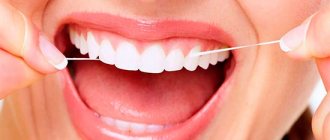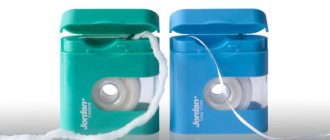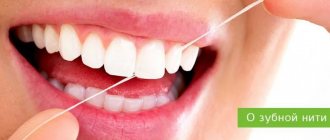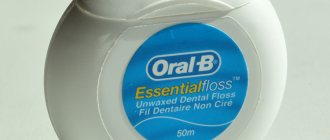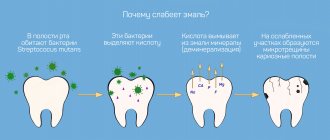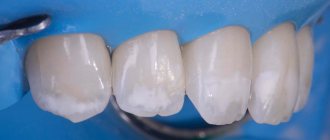4413
In the process of providing therapeutic assistance during dental treatment, the doctor often causes mechanical trauma to the surrounding tissues of the gums and organ enamel.
At the same time, the damage is not accidental; it is necessary for the highest quality of medical procedures.
One of these actions is retraction of the gum area.
Purpose of gum retraction procedure
In medical terminology, retraction is interpreted as the deliberate pulling back of the soft tissue of the gum, as a result of which its groove is subject to artificial expansion.
This, in turn, opens the root part to the required size, and the threshold of the external and internal boundaries of the tooth is significantly lowered.
This method is carried out using special threads made from twisted dense fiber of various thicknesses and sizes.
Devices are produced individually and subjected to high-tech processing.
Types and choice of material
Mechanical retraction is carried out using rings, silicone caps, twisted, braided threads. Three types of threads are used:
- not impregnated with a special composition, for persons with allergies to chemical components, who have pathologies in the cardiovascular system (adrenaline is used in the impregnation),
- cotton – elastic and soft, have a hemostatic effect,
- fabric tubes - produce an effect similar to cotton tubes, but are better retained on the edge of the gums due to their inherent structure.
To read: Is it normal for a 9 month old baby to have no teeth?
Copper rings are rarely used, due to the difficulty of selecting them in exact accordance with the size of the patient’s dental neck.
The modern method of retraction is laser, which has not yet been fully studied in terms of contraindications and is very expensive. In orthopedics, the method of retraction with a special paste has proven itself to be useful for obtaining impressions for prosthetics.
Its protective effect lasts no more than 5 minutes, which does not allow using this method when working with caries.
Indications and contraindications
The root exposure procedure using pulling threads is indicated in the following clinical cases:
- bite defects of any severity;
- removal of destroyed fragments of the jaw row;
- gum therapy;
- during anesthesia to enhance the targeted effect of the drug;
- with professional whitening in a clinic;
- in the production of veneers and crowns;
- when removing rocky deposits using ultrasonic influence;
- as a manipulation that stops bleeding that occurs during the treatment of surgical actions of a doctor.
Contraindications to the procedure have not yet been thoroughly identified. The main thing that should be adhered to is the absence of inflammatory, purulent and infectious lesions of the soft tissues of the oral cavity.
Gum retraction, indications for the procedure
In the process of dental treatment, dentists often, for one reason or another, have to injure the gums surrounding the teeth in order to perform the task efficiently. One of these “injuries” is called gum retraction.
The word “retraction” literally translates as “pulling back,” which shows the essence of the manipulation. Gum retraction is the widening of the gingival groove, due to which the tooth root is exposed and the level of the gum decreases.
Indications for gum retraction:
- The need to protect the gums from gingival fluid and trauma during dental treatment;
- Bleeding during other dental procedures;
- Retraction is carried out if it is necessary to manipulate the part of the tooth located under the gum;
- Manufacturing and installation of crowns, veneers or dentures;
- Teeth whitening.
Basic techniques for gum retraction
There are three main methods of gum retraction.
Surgical method
The surgical method is the complete removal of part of the gum tissue using electrical surgical instruments or a simple scalpel. This method is very radical, so it is used only in two cases:
- If you need to correct your gums;
- If all other methods are not suitable for some reason.
Mechanical method
Mechanical gum retraction involves the use of rings, caps and sutures. These objects are inserted under the gum, due to which it moves away. The mechanical method is painful, so it is most often performed under local anesthesia.
In addition, mechanical retraction requires a lot of time, since the doctor must constantly monitor the depth to which the retraction is carried out, and carry out all manipulations slowly and carefully, measuring the depth of the periodontal sulcus.
Because of this complexity, mechanical retraction is practically no longer carried out, especially if it is necessary to move the gums back on several teeth at once.
In addition to the complexity, mechanical retraction has another disadvantage.
Since gum tissue is very sensitive, even a slight mechanical impact on it can cause severe bleeding or even damage to the attachment of the tooth in the jaw bone.
Chemical method
The essence of the chemical method is the use of special gels, solutions or pastes that promote contraction of gum tissue, due to which its edge is temporarily retracted.
It should be said right away that the chemical method is not applicable to all patients, since most retraction drugs contain adrenaline.
Even in small quantities, this substance increases blood pressure and causes rapid heartbeat, which is contraindicated for people with heart rhythm disorders, hypertension and ischemia.
In addition, the gum tissue may simply reject the chemicals, in which case chemical retraction will not be possible.
Products with kaolin and aluminum oxide are considered to be the most gentle for gum retraction. They are produced in the form of a paste or gel and are placed in special cartridges that allow precise control of application to the gums. In the chemical method, it is very important to observe the duration of exposure to prevent chemical burns.
Combined gum retraction technique
In modern dentistry, the three main techniques are very rarely used separately - dentists prefer to combine them. The most popular is the combined mechanical-chemical method.
When using this method, the dentist uses retraction threads or rings that are impregnated with a special chemical composition. This composition not only blocks all pain, but also prevents the gums from bleeding. In addition, this method allows you to provide the most convenient access to the tooth for a fairly long time.
Most often, retraction threads are used for combined retraction. For retraction to be successful, the doctor must accurately determine the width and depth of the gingival groove, and then select threads of the appropriate size and thickness.
Just as in the chemical method, the doctor must find out whether the patient suffers from heart disease, and whether he has allergies or intolerance to certain chemicals.
No more than four threads can be used at a time to prevent chemical burns.
There are three types of retraction cords:
- Cotton, twisted from fibers. They are distinguished by good absorbent properties and high softness;
- Fabric tubes. In terms of absorbent qualities, they are similar to cotton threads, but thanks to a well-thought-out weaving configuration, these threads are better placed in the gum groove. These threads are considered the best for retraction;
- Threads not impregnated with chemical composition. They are used for mechanical retraction if the patient cannot undergo combined retraction for any reason.
Now new retraction techniques based on the use of diode lasers have begun to appear.
They are absolutely safe and painless, but the equipment for such retraction is very expensive.
Useful article?
Save so you don't lose!
Source: https://www.32top.ru/stat/1099/
Selection and types of material
The threads can be either completely dry or treated with agents with a therapeutic effect. The last option is used most often.
The choice of product always remains with the specialist - it is he who, based on the clinical situation, will choose the best option.
There are often cases when a patient suffers from individual intolerance to the components of medications, so it is necessary to use dry material.
The qualitative composition of the retraction thread differs by type:
- 100% cotton – treated with compounds that stop bleeding and have a disinfecting effect;
- cotton without impregnation - indicated when other options are unacceptable for clinical reasons;
- Tubular fabric – characterized by increased moisture absorption.
By appearance:
- twisted - not very strong and durable. They often tear, breaking up into individual fibers;
- knitted - indicated for use only to ensure the integrity of soft tissue fragments during dental preparation;
- wicker ones are the most durable and multifunctional products.
Features of dental treatment under a microscope, pros and cons of the method.
Come here if you are interested in the intricacies of using rubber dams in dentistry.
At this address https://www.vash-dentist.ru/lechenie/zubyi/karies/innovatsionnoe-ustraneniei-icon.html we’ll talk about Icon treatment of caries.
Medical Internet conferences
The term retraction (from the Latin Retractio) literally means pulling, contracting, wrinkling. By this word, orthopedic dentists understand the pharmacomechanical expansion of the gingival sulcus in order to introduce impression material into its gaping cavity to accurately depict the ledge, tooth neck and bottom of the sulcus [1]. Gingival retraction was first described in 1941 by Thomson. To mechanically expand the periodontal sulcus, he used moistened twine [2, 3]. Currently, epinephrine, alum (double sulfate of aluminum and an alkali metal), aluminum chloride, aluminum sulfate, zinc chloride, tannic acid and ferrous sulfate are used to impregnate threads. This work examines threads without impregnation (Ultrapak) impregnated with epinephrine (GINGI- PAK) and aluminum chloride (SURE-Cord).
Ultrapak, Sure Cord - Retraction cords are made from 100% cotton, which is knitted in a chain of thousands of tiny loops. The thread is available in sizes from 000 to 3.
The Gingi-Pak retraction thread also consists of 100% cotton, available in sizes from 00 to 3. The thread impregnated with epinephrine HCl significantly affects periodontal tissue, therefore it is not recommended to carry out retraction with these threads in case of periodontal diseases [4, 5, 6] . In addition, only epinephrine solution was found to cause long-term vasoconstriction and prevent bleeding after thread removal [6]. In situations in which the use of epinephrine HCl is contraindicated, it is recommended to use a retraction cord impregnated with aluminum chloride. Here, a solution of epinephrine and aluminum chloride is cytotoxic to cell cultures of gingival fibroblasts [7, 8]. In clinical cases in which no medication can be used, a suitable size suture without impregnation should be used for the retraction procedure.
When analyzing the results obtained, it was found that a retraction thread without impregnation makes it possible to slightly move the marginal gum, which can be complicated by improper cutting of the plaster stamp and inaccurate fit of the crown to the natural stump of the tooth. In addition, placing the thread in the periodontal sulcus caused unpleasant or painful sensations in the patient. Also, a retraction thread without hemostatic fluid turned out to be the least effective in terms of impression quality, since the local tissues restored their volume immediately after removal of the thread. Another disadvantage of the thread was bleeding after its removal, which complicates the work of the dentist. The only, but important, advantage of this thread is that it can be used in people with existing somatic pathologies, since it does not affect the general condition of the patient.
Stages of staging
The technique of performing tissue retraction is carried out in several successive stages:
- instrumental study of the furrow , replacement of its parameters and required depth;
- administration of an anesthetic drug;
- preparation of the thread - impregnation with a hemostatic agent, determination of dimensions. Everything is done in strict sterility to prevent infection of the internal layers;
- the product is inserted to a shallow depth , after which the tooth is treated;
Upon completion of all therapeutic measures, the doctor uses a sharp device to pull the end and pull the thread out of the cavity.
Methods used
In medical practice, several methods are available to retract the soft tissue of the gums. Which one to prefer is the prerogative of the doctor. The decision is made based on the complexity of the diagnosis and the specifics of its treatment.
Mechanical method
The thread is packaged in a special tube and comes with a blade. They are dry and medicated.
Step-by-step algorithm for the doctor’s actions:
- anesthesia of the working surface;
- preparation - determining the length of the bundle, impregnating it with the composition (if necessary);
- packing - to the required depth using a special packer device, the product is delivered to the required place. The manipulation is carried out slowly and carefully. Normally, the patient should not experience discomfort;
- cutting off excess ends with scissors.
The procedure is simple, this is its advantage. Belongs to the category of gentle measures.
Has disadvantages:
- risk of accidental injury to soft tissue mucosa;
- duration in time;
- small fragments of fibers can impair the aesthetic content during subsequent restoration.
Causes of yellow plaque on teeth and how to get rid of the problem.
This publication contains all the most important things about root canal cleaning.
Read here about the symptoms of a tooth abscess and its treatment methods.
Surgical
The method is indicated for pathological growth of soft tissues in the border zone of the gums. This clinical picture makes it impossible to use other techniques.
The manipulation is performed under local anesthesia in a standard manner. The main tool is the surgeon's scalpel.
Modern dental clinics use bloodless laser technology for this purpose, but this service is available only to prestigious medical institutions.
The surgical method is fraught with complications of varying degrees of intensity, the main of which are:
- formation of a purulent pocket;
- development of internal inflammation;
- excessive root exposure;
It has a serious contraindication to the procedure – periodontitis. Retraction is often accompanied by pain.
Chemical
The main purpose of the method is to provide impressions. Additional accessories - a syringe and a gel-based product. Step-by-step introduction technology:
- The paste is drawn into a syringe and distributed into the gum cavity. Then it is lightly pressed down by the coronal part of the organ;
- after a few minutes the mixture is removed, not leaving even small fragments. The working surface is washed with running water;
- the crown dries naturally.
Flaws:
- the risk of chemical burns if the exposure time of the paste is incorrectly calculated;
- the possibility of manifestations of individual intolerance to the components of the product.
The advantage is the speed of manipulation and high results.
Combined
A combination of two options is possible:
- the use of products impregnated with a therapeutic composition immediately before administration;
- threads and pastes are used in a certain order, alternately. This way you can expand the groove more efficiently. The thread for this purpose is taken with the smallest diameter. A few minutes after implantation, it is removed, and a gel drawn into a syringe is applied to this area.
Retraction thread in dentistry - a small helper in solving big problems
585
In the process of providing therapeutic assistance during dental treatment, the doctor often causes mechanical trauma to the surrounding tissues of the gums and organ enamel.
At the same time, the damage is not accidental; it is necessary for the highest quality of medical procedures.
One of these actions is retraction of the gum area.
Purpose of gum retraction procedure
In medical terminology, retraction is interpreted as the deliberate pulling back of the soft tissue of the gum, as a result of which its groove is subject to artificial expansion.
This, in turn, opens the root part to the required size, and the threshold of the external and internal boundaries of the tooth is significantly lowered.
This method is carried out using special threads made from twisted dense fiber of various thicknesses and sizes.
Devices are produced individually and subjected to high-tech processing.
Indications and contraindications
The root exposure procedure using pulling threads is indicated in the following clinical cases:
- bite defects of any severity;
- removal of destroyed fragments of the jaw row;
- gum therapy;
- during anesthesia to enhance the targeted effect of the drug;
- with professional whitening in a clinic;
- in the production of veneers and crowns;
- when removing rocky deposits using ultrasonic influence;
- as a manipulation that stops bleeding that occurs during the treatment of surgical actions of a doctor.
Contraindications to the procedure have not yet been thoroughly identified. The main thing that should be adhered to is the absence of inflammatory, purulent and infectious lesions of the soft tissues of the oral cavity.
Selection and types of material
The threads can be either completely dry or treated with agents with a therapeutic effect. The last option is used most often.
The choice of product always remains with the specialist - it is he who, based on the clinical situation, will choose the best option.
There are often cases when a patient suffers from individual intolerance to the components of medications, so it is necessary to use dry material.
The qualitative composition of the retraction thread differs by type:
- 100% cotton – treated with compounds that stop bleeding and have a disinfecting effect;
- cotton without impregnation - indicated when other options are unacceptable for clinical reasons;
- Tubular fabric – characterized by increased moisture absorption.
By appearance:
- twisted - not very strong and durable. They often tear, breaking up into individual fibers;
- knitted - indicated for use only to ensure the integrity of soft tissue fragments during dental preparation;
- wicker ones are the most durable and multifunctional products.
Stages of staging
The technique of performing tissue retraction is carried out in several successive stages:
- instrumental study of the furrow , replacement of its parameters and required depth;
- administration of an anesthetic drug;
- preparation of the thread - impregnation with a hemostatic agent, determination of dimensions. Everything is done in strict sterility to prevent infection of the internal layers;
- the product is inserted to a shallow depth , after which the tooth is treated;
Upon completion of all therapeutic measures, the doctor uses a sharp device to pull the end and pull the thread out of the cavity.
Methods used
In medical practice, several methods are available to retract the soft tissue of the gums. Which one to prefer is the prerogative of the doctor. The decision is made based on the complexity of the diagnosis and the specifics of its treatment.
Mechanical method
The thread is packaged in a special tube and comes with a blade. They are dry and medicated.
Step-by-step algorithm for the doctor’s actions:
- anesthesia of the working surface;
- preparation - determining the length of the bundle, impregnating it with the composition (if necessary);
- packing - to the required depth using a special packer device, the product is delivered to the required place. The manipulation is carried out slowly and carefully. Normally, the patient should not experience discomfort;
- cutting off excess ends with scissors.
The procedure is simple, this is its advantage. Belongs to the category of gentle measures.
Has disadvantages:
- risk of accidental injury to soft tissue mucosa;
- duration in time;
- small fragments of fibers can impair the aesthetic content during subsequent restoration.
Surgical
The method is indicated for pathological growth of soft tissues in the border zone of the gums. This clinical picture makes it impossible to use other techniques.
The manipulation is performed under local anesthesia in a standard manner. The main tool is the surgeon's scalpel.
Modern dental clinics use bloodless laser technology for this purpose, but this service is available only to prestigious medical institutions.
The surgical method is fraught with complications of varying degrees of intensity, the main of which are:
- formation of a purulent pocket;
- development of internal inflammation;
- excessive root exposure;
It has a serious contraindication to the procedure – periodontitis. Retraction is often accompanied by pain.
Chemical
the purpose of the method is to provide impressions. Additional accessories - a syringe and a gel-based product. Step-by-step introduction technology:
- The paste is drawn into a syringe and distributed into the gum cavity. Then it is lightly pressed down by the coronal part of the organ;
- after a few minutes the mixture is removed, not leaving even small fragments. The working surface is washed with running water;
- the crown dries naturally.
Flaws:
- the risk of chemical burns if the exposure time of the paste is incorrectly calculated;
- the possibility of manifestations of individual intolerance to the components of the product.
The advantage is the speed of manipulation and high results.
Combined
A combination of two options is possible:
- the use of products impregnated with a therapeutic composition immediately before administration;
- threads and pastes are used in a certain order, alternately. This way you can expand the groove more efficiently. The thread for this purpose is taken with the smallest diameter. A few minutes after implantation, it is removed, and a gel drawn into a syringe is applied to this area.
Recommendations for the rehabilitation period
The recovery period after using this technique and targeted treatment may include physical discomfort, pain, bleeding, and swelling of the mucosal tissue.
To minimize these sensations, you should use products that strengthen the gums and relieve inflammation:
- medicinal ointments and gels;
- rinsing with decoctions of medicinal plants;
- in difficult cases - a course of antibiotics.
Teeth should be brushed only with a soft brush, with pastes that do not contain abrasive and whitening components, preferably on a professional basis.
Carefully remove food residues by rinsing and using an irrigator in a gentle mode.
You should avoid eating too cold, hot foods and drinks, hard, sticky and viscous foods that can injure the affected areas.
Possible complications
The quality of the actions performed depends on the doctor’s qualifications and practice. Medical unprofessionalism is the most common cause of complications.
Less often, they occur against the background of non-compliance with hygiene measures and the patient’s weak immune system.
Possible complications:
- aggravation of periodontitis by the formation of pockets;
- too much exposure of the root zone, caused by very deep immersion of the thread.
A careful study of the clinical picture and the experience of a specialist will help to avoid these problems. To eliminate it, more radical methods are used, including surgical intervention.
Popular manufacturers
The following materials from well-known brands engaged in the production of dental instruments, devices and dental care products have proven themselves better than others:
- Gingi Pack – composition – cotton, impregnation – aluminum sulfate. It has a unique texture, holds firmly in your hands, and does not slip. The applied composition is distributed along its entire length as evenly as possible, and comes with convenient packaging and a cap that eliminates the need to use scissors. The fibers do not crumble, the fabric is sterile - 100%. If necessary, it can be impregnated with additional composition;
- Sure Cord - its structure is a set of microscopic twisted fibers interconnected into a durable fabric. Fits securely into the groove. Extensive range of sizes, thickness varies in the required range. An ideal solution for installing veneers.
Price
The cost of the procedure is determined by two components - the price of the material and payment for the services of a specialist. How much the manipulation will cost depends on the region of residence of the patient, the clinic, and the qualifications of the doctor. On average, it costs about 550 rubles, excluding painkillers.
Thread price:
- Gingi Pack – from 380 rubles;
- Sure Cord – from 740 rubles.
The video provides additional information on the topic of the article.
Reviews
Without gum retraction, it is impossible to treat a large number of dental diagnoses; it is difficult to carry out prosthetics and professional hygiene measures.
If you have already experienced the therapeutic benefits of this technique, or you did not like something in the process of its implementation, you can share your own opinion in the “comments” section.
, please select a piece of text and press Ctrl+Enter.
Source: https://www.vash-dentist.ru/lechenie/zubyi/retraktsionnaya-nit-v-stomatologii.html
Recommendations for the rehabilitation period
The recovery period after using this technique and targeted treatment may include physical discomfort, pain, bleeding, and swelling of the mucosal tissue.
To minimize these sensations, you should use products that strengthen the gums and relieve inflammation:
- medicinal ointments and gels;
- rinsing with decoctions of medicinal plants;
- in difficult cases - a course of antibiotics.
Teeth should be brushed only with a soft brush, with pastes that do not contain abrasive and whitening components, preferably on a professional basis.
Carefully remove food residues by rinsing and using an irrigator in a gentle mode.
You should avoid eating too cold, hot foods and drinks, hard, sticky and viscous foods that can injure the affected areas.
Recommendations
For some time (during the recovery period), redness and swelling of the mucous membrane will persist, and the gums will hurt.
You will need to adhere to the following restrictions and rules of care:
- after retraction for 6-8 hours it is forbidden to eat or drink anything hot. After eating, you need to rinse your mouth with furatsilin, decoctions of medicinal herbs with anti-inflammatory properties,
- gently brush your teeth only with a soft brush (medicated paste), avoiding damage to the gums,
- refrain from visiting swimming pools, saunas,
- Dentol, Solcoseryl gels will help reduce swelling and reduce pain,
- Maybe
Antibiotic therapy (as prescribed by a doctor) will be required to relieve inflammation.
Possible complications
The quality of the actions performed depends on the doctor’s qualifications and practice. Medical unprofessionalism is the most common cause of complications.
Less often, they occur against the background of non-compliance with hygiene measures and the patient’s weak immune system.
Possible complications:
- aggravation of periodontitis by the formation of pockets;
- too much exposure of the root zone, caused by very deep immersion of the thread.
A careful study of the clinical picture and the experience of a specialist will help to avoid these problems. To eliminate it, more radical methods are used, including surgical intervention.
Popular manufacturers
The following materials from well-known brands engaged in the production of dental instruments, devices and dental care products have proven themselves better than others:
- Gingi Pack – composition – cotton, impregnation – aluminum sulfate. It has a unique texture, holds firmly in your hands, and does not slip.
The applied composition is distributed along its entire length as evenly as possible, and comes with convenient packaging and a cap that eliminates the need to use scissors.The fibers do not crumble, the fabric is sterile - 100%. If necessary, it can be impregnated with additional composition;
- Sure Cord - its structure is a set of microscopic twisted fibers interconnected into a durable fabric. Fits securely into the groove. Extensive range of sizes, thickness varies in the required range. An ideal solution for installing veneers.
Price
The cost of the procedure is determined by two components - the price of the material and payment for the services of a specialist. How much the manipulation will cost depends on the region of residence of the patient, the clinic, and the qualifications of the doctor. On average, it costs about 550 rubles, excluding painkillers.
Thread price:
- Gingi Pack – from 380 rubles;
- Sure Cord – from 740 rubles.
The video provides additional information on the topic of the article.
The nuances of using retraction dental floss in dentistry
1400
Recently, domestic dentists have been practicing the retraction procedure, which is a reduction of soft tissues in order to slightly open the gum groove for a certain time.
A similar procedure is carried out in various ways using a retraction thread, the characteristics and implementation features of which we invite you to take a closer look at.
Methods
The choice of the method by which the gums will be pulled back with a thread is made by the dentist based on the research results.
Next, the specialist consults the client and begins work. So, in dental practice, four methods of gum retraction are used - mechanical, chemical, surgical and combined. You can learn more about each of them below.
Chemical method
The presented technique involves the use of solutions, pastes and gels, the effect of which leads to a reduction in periodontal tissue.
The drug is usually placed in the periodontal sulcus. The chemical composition includes a small concentration of adrenaline. Therefore, the disadvantage of the procedure is that it cannot be performed for patients suffering from cardiovascular diseases .
Good homeostasis means that the free gum margins are not damaged. The choice of one or another drug is made by the dentist.
In exceptional cases, the selection can be carried out jointly with the patient, in which the specialist focuses on the financial capabilities of the latter, selecting the most suitable drugs for the price.
The solution or paste is administered using a special gun or syringe. Residues are washed thoroughly. Another disadvantage is the possibility of burns.
Combined method
Retraction using a combined method usually includes two options:
- the use of threads pre-impregnated with a drug. The procedure is performed in a dental office. An alternative option is to purchase ready-made threads available at the pharmacy;
- alternate use of gels and threads. First, the dentist widens the periodontal sulcus, after which he applies a special gel or paste to the treated area, using appropriate medical instruments.
Prices
Today, the cost of Sure Cord threads varies from 400 to 450 rubles, depending on the offers of online stores or pharmacies.
For Gingi Pak products you will have to pay about 450-500 rubles. Prices may vary depending on three parameters - the type of binding, the type of production materials, and the length of the product. Products are supplied in plastic packaging.
For the retraction procedure itself you will have to pay approximately 200-250 rubles per tooth. The price includes labor only. The client pays separately for the materials themselves.
You can purchase threads yourself, but before doing so, be sure to consult with your doctor.
The video provides additional information on the topic of the article.
A specialized clinic first conducts a visual inspection, and only then indicates the price along with materials.
Reviews
Without gum retraction, it is impossible to treat a large number of dental diagnoses; it is difficult to carry out prosthetics and professional hygiene measures.
If you have already experienced the therapeutic benefits of this technique, or you did not like something in the process of its implementation, you can share your own opinion in the “comments” section.
If you find an error, please select a piece of text and press Ctrl+Enter.
Tags gum treatment retraction thread
Did you like the article? stay tuned
Previous article
Basics of electrophoresis for teeth
Next article
Renewing your smile with artistic dental restoration



